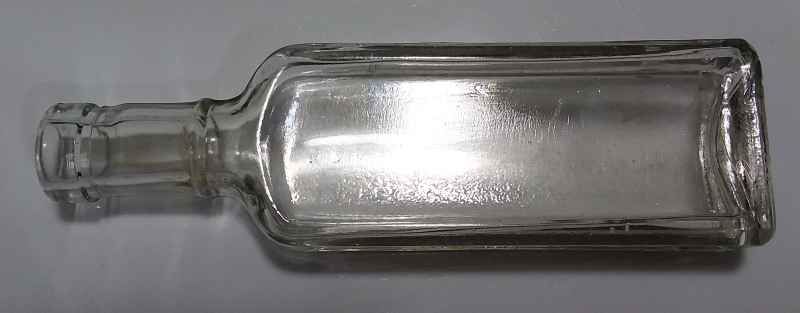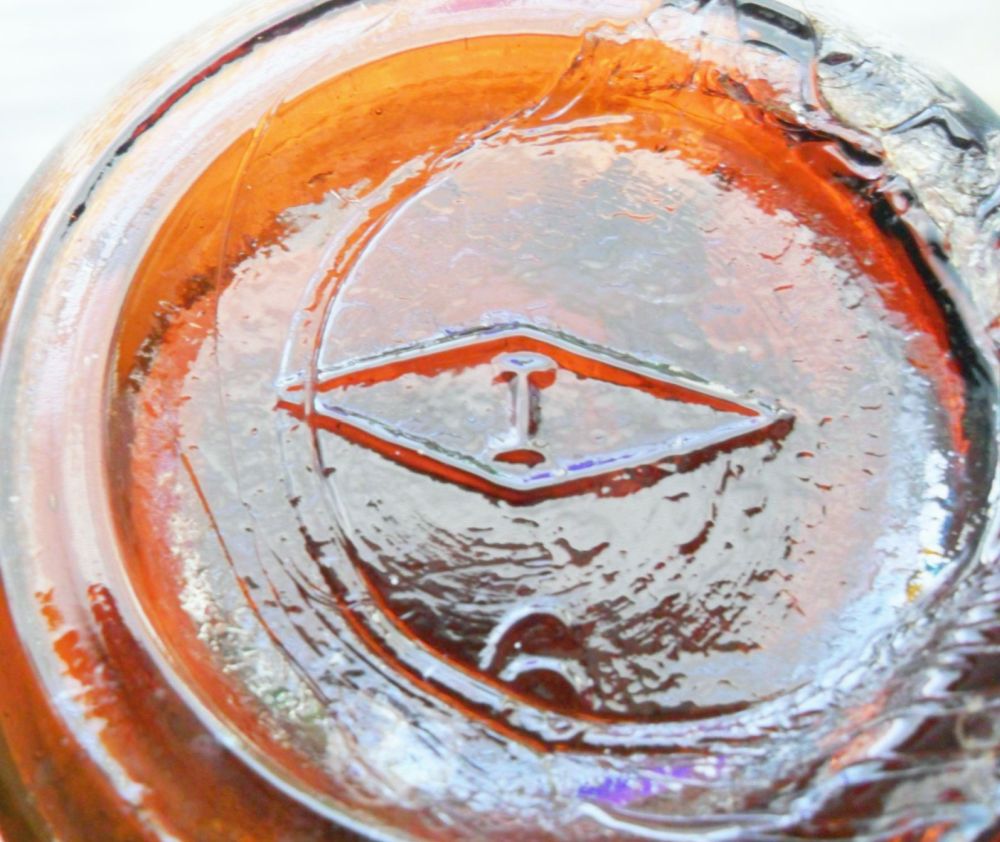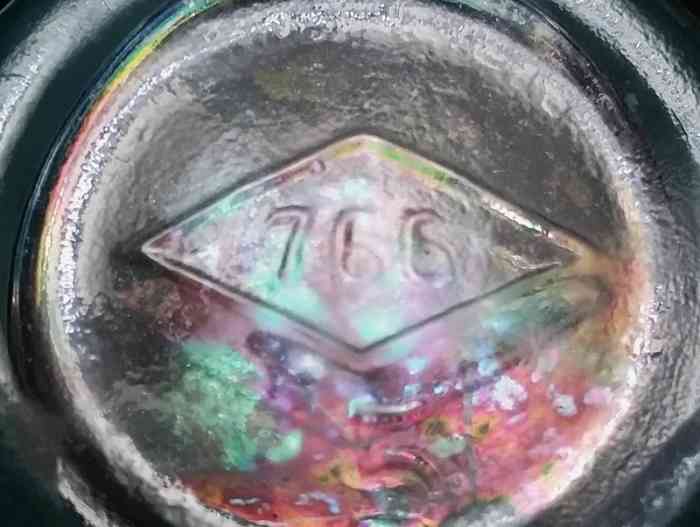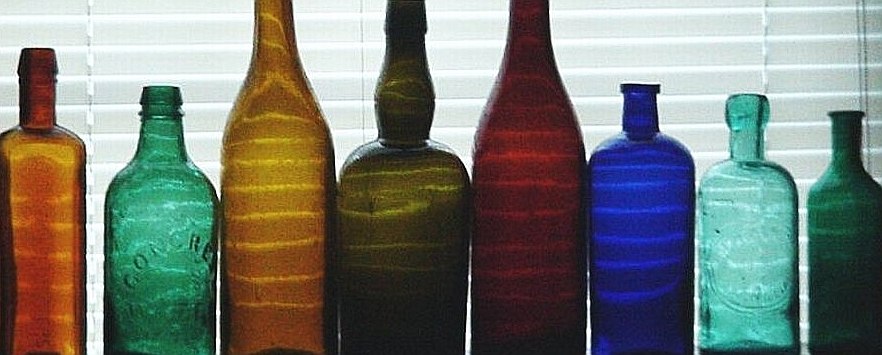ILLINOIS GLASS COMPANY
Alton, Illinois (1873-1929)
(This particular mark used circa 1915-1929)
The Illinois Glass Company was started by William Eliot Smith and Edward Levis, incorporating at Alton, Illinois in March of 1873. During the earlier years, many of their bottles carried an “I. G. CO.” mark, and later an “I G CO inside a diamond” logo. See more info on those marks on Page Three.


This “I inside a Diamond” mark was used by Illinois Glass from 1915 up to 1929, and is seen on large numbers of antique and vintage glass bottles of many types. ABM (Automatic bottle machine) production was begun at Illinois Glass in 1910, and although it seems more likely the “I in a diamond” trademark would have been first used around that same time, the U.S. Patent & Trademark Office data indicates Illinois Glass Company actually claimed that use of this particular trademark on glassware began on June 1, 1915. However, the trademark was not officially registered until March 1, 1927 (TM #224,561).


The “I in a diamond” mark is seen on HUGE numbers of containers. The great majority of these bottles were made in clear glass, with a smaller percentage found in amber glass, light aqua, or occasionally cobalt blue. Some bottles made originally in clear glass may turn a faint grayish or light amethyst shade from sun exposure. Darker shades of purple indicate the glass color has been altered in recent years via irradiation (“nuking”) . (Please see this page on irradiated bottles or artificially purpled glass) . Illinois Glass Company bottles were NEVER manufactured originally in dark purple glass!

Many, many hundreds (if not thousands) of different styles of bottles made by Illinois Glass Company are known. Many of those were standard “packer ware” or “generic” types, used for a multitude of different products – medicines, salves, foods, sauces, extracts, flavorings, chemicals, cleaning products, bleach, vinegar, cosmetics, etc. The end user company would have affixed their own private brand label on the side with information on the product. Often, there are no embossed markings on the bottle other than the logo seen on the very bottom.
Many of these bottles are found in old trash dump sites, buried in privy pits (locations where an outhouse once stood), and anywhere old farmsteads were located. They were distributed far and wide, and are found virtually nationwide – throughout the United States.
ADVERTISEMENT
As far as I know, the “I inside a diamond” mark is only seen on machine-made bottles (perhaps with the exceptions of some very large hand-blown bottles, or special-order, limited-production items) which exhibit the typical Owens machine suction scars on the base. The “Owens scar” is a more or less circular, thin seam, “line” or discontinuity in the surface of the glass, visible around the perimeter of the bottom of the bottle produced by those particular machines: the Owens Automatic Bottle machines. The scar seam can have a somewhat irregular, jagged appearance.
Typically, the “I” is discernible within the diamond, but on very small bottles it may be indistinct, incomplete, distorted or “smeared” in appearance. Sometimes the “strike” or “impression” is so light that the mark can just barely be seen, and then only on close examination under a bright light shone at an angle.
In some cases the steel mold might have had dirt, debris or graphite (mold release agent) buildup filling in the engraving (incising), resulting in a “missing I” on the finished bottle. In some cases, a bottle with just a plain diamond (no “I”) MIGHT be a product of the Diamond Glass Company, of Royersford, Pennsylvania. In some of these cases it is will not be clear which company was the maker.
The “I” is sometimes misinterpreted as the “number 1”, and often does looks quite like a numeral “one” on some examples. On some very small bottles, the “I” may look more like a raised period (dot) inside the diamond, or be entirely missing.

Diamond with Numbers Placed Inside
There are also many bottles known with a number or number/letter combination positioned within the diamond. These are also products of Illinois Glass Company, and some of the these numbers have been matched up with bottle style listings in early trade catalogs published by Illinois. Just for one example, the base photo above pictures the diamond mark with the number “766” placed within. That was the mold number (catalog number) assigned to a small 2 ounce generic medicine bottle. The bottle is lettered “2 FLD OZS.” on one side just below the shoulder.
LYRIC Bottles
The name “LYRIC” was used by Illinois also, and this is a brand name they assigned to a line of pharmaceutical (prescription) bottles, and is often seen on the base of those types of bottles. In many cases, the diamond mark is embossed along with “LYRIC”. See this page on the LYRIC bottles.
Illinois Glass Company had a very large manufacturing facility at Alton, IL, with over a thousand employees working there during the heyday of its operation.
Other glass manufacturing plants that were purchased by, and became part of Illinois Glass Company during its operation include the Thompson Bottle Company of Gas City, Indiana (acquired 1913) ; Chicago Heights Glass Company, Chicago Heights, Illinois (1913) , and Cumberland Glass Manufacturing Company of Bridgeton, New Jersey (1920).
Illinois-Pacific Glass Co. plants (at Los Angeles and San Francisco, CA) were organized as a wholly-owned subsidiary of Illinois Glass in 1902. (See IPG and IPGCO marks on Glass Bottle Marks, Page Three.)
In 1929, Illinois Glass merged with Owens Bottle Company of Toledo, Ohio to form the Owens-Illinois Glass Company. Owens Bottle Company produced tremendous numbers of bottles, jars and other containers with the O inside a Square mark which is also frequently seen on bottles from the 1920s.
ADVERTISEMENT
The Alton factory (in later years, Owens-Illinois plant #7) finally closed in 1983. Most bottles made after the Owens-Illinois merger that were made at the Alton factory CAN BE IDENTIFIED by the number “7” placed to the left of the glassmaker logo. Please see my page on Owens-Illinois Glass Company for more information on the plant location codes.
NOTE: this mark (especially when the I has very prominent serifs or “crossbars”) is sometimes confused with an “H in a diamond” mark which was used by the Heisey Glass Company (A H. Heisey & Company, Newark, Ohio, 1896-1957). The Heisey mark is seen only on high quality pressed and blown glassware, elegant pattern glass tableware, etc., not on utilitarian and commercial-type bottles which were the mainstay of Illinois Glass production.
For more in-depth information on Illinois Glass Company, its history, and the various identification marks they used, check out this article (by Bill Lockhart, et al) at:
The Dating Game: Illinois Glass Company.
A very informative, detailed article (written by Jessica Mills) on Illinois Glass Company at Alton (and its successor Owens-Illinois) can be found here, on the “Madison Historical” Madison County, Illinois archives site:
https://madison-historical.siue.edu/encyclopedia/the-owens-illinois-glass-company/
A great resource for learning more about Illinois Glass Company containers (and older utilitarian-type glass bottles in general) would be this webpage (hosted by Bill Lindsey) with links to pages from an original 1920 Illinois Glass Company bottle catalog: Illinois Glass Company – 1920 Catalog pages .
Clicking on the links on that page will bring up photographs of individual catalog pages with drawings illustrating many of the designs sold by Illinois, including “standard” and “generic” packers and many other types. Most, if not all, of the containers shown were marked on the base with the Diamond-I trademark. The typical “bottle type terminology” used by glass manufacturers of that period will be a help to archaeologists, collectors or anyone interested in antique bottles from the early 20th century. There are also other Illinois Glass Co. catalogs shown on the site including one circa 1906: https://www.sha.org/bottle/igco_1906.htm .
Please click here to go to my Glass Bottle Marks Website Home Page
For an extensive list of glass manufacturers’ marks seen on bottles, fruit jars, electrical insulators, tableware and other glassware, please click here to go to the Glass Bottle Marks pages (Page One).
Check out my summary page on Sea Glass / Beach Glass. Sometimes Illinois Glass Company bottle bases are found among so-called “Beach Glass.”
ADVERTISEMENT


Pepsi Cola pat 120 277
https://photos.app.goo.gl/gGXDQbvP4Wg1qkm5A
I know about most of the information about this bottle but is this a mistake in the logo! The I is 180 degrees is in the wrong direction.
Help please, I have found that the Illinois company has a lot of mistakes around the time of the merger.
Thank you
Lisa
Hi Lisa,
I’m really not sure what that mark is supposed to be. I have doubts that it indicates the Illinois Glass Company. I’m not even sure that is actually supposed to be an “I inside the diamond”. Perhaps readers who are more familiar with older Pepsi bottle variants and their makers can chime in here with better information for us. Thanks and take care!
David
Hello – we recently found out (about a month ago) that part of our property (27.5 acres) was formerly used as the [small town] dump site. We have found various bottles and other items, some of which I’ve been able to identify. The most recent find is a fairly large (24 fl oz) amber colored bottle with some markings still faintly visible. The bottom of the bottle has the following marks:
9 47
Below the “I” is the number 2
Duraglas
G102
The bottle advertises “sparkling alu-taris” (I think), “The 100% natural alkaline mineral water” – some of the paint left on is orange, white, and red – some of the words are in red. Very faintly on the back it reads (as best as I can make out because it’s “ghost” writing): Since 1878 – the finest hi [can’t read] water product – this 100% natural al . . . mineral water carb . . .bottled and sealed at its source”. Can you help me identify what this bottle originally looked like and its age?
Hi Michelle,
From the info you supplied, your bottle was made by Owens-Illinois Glass Company. The “9” is a plant location code for their Streator, Illinois factory. The “47” is a date code for 1947 which is the year the bottle was made. Duraglas was the brand name for their container glass, and that brand was embossed on many of their bottles for many years after 1940. The “G102” is a code number that indicated a specific bottle style, regardless of the wording or embossing in the glass, the label, or the glass color. (You can find similarly shaped bottles by searching for soda bottles on ebay and including the “G 102” or “G102” in your keyword search, and checking the box for searching the entire item descriptions as well as the title.) I am not familiar with the product that your bottle contained. Owens-Illinois manufactured TREMENDOUS numbers of bottles for thousands of companies around the US and the world. It might have been a rather short-lived company or product! Hope this helps!
David
I found a brown 100ml bottle with a cork. It has the “I inside the Diamond” but it also has a circle around the I. Its it stamped with a 7 on the left side of the logo and 3 on the right, with 1845 stamp underneath the logo. I cant seem to find a age or time frame when this might have been made. Or the “diamond I” with a circle around it.
Hi Brian,
Your bottle was made by Owens-Illinois Glass Company, as shown by the “Diamond and oval with an I inside”. You can see more info on that company and its marks on my page devoted to Owens Illinois. The “7” is a plant code for their Alton, Illinois location. The “3” on the right of the logo is a date code for either 1933, 1943 or 1953. I can’t be sure which year is correct, although I suspect 1933. The number “1845” is a catalog/design number assigned to a popular series of chemical bottles, made in many sizes. It has nothing to do with the year 1845. Please see my answer about these bottles to a post in the COMMENTS section published under the webpage “Glass Bottle Marks – Page 5” on May 2, 2019, in answer to “REBECCA”. I hope this helps,
David
I have a light blue rose pattern 2 piece bowl with an oval and a cursive f or l
Hi Brooke,
From your description I think you are describing one of the marks used by Fenton Art Glass Company. Please see the alphabetical GLASS BOTTLE MARKS “F” listings and my individual webpage on Fenton.
Hope this helps,
David
Thank you for all of the information that you have shared! Great resource! Happy hunting!
Thanks Darcy!!
David
I have a Presto Supreme Mason jar. On the bottom is a circle and inside the circle is M something else then BR, has a diamond with a 1 in it and 21 on the bottom by its self. The bottom side of the jar says MFD. By Illinosis glass co. underneath that is w5ox. The zinc lid a a male threaded opening. Any idea of age of this jar?
Hi Ray, the jars marked “Illinois Glass Co” date before 1929, when IGCO combined with Owens Bottle Company to become Owens-Illinois Glass Company. I have no way of narrowing down the date range on your Presto jar. Presto jars were made for many years, both before and after the merger with Owens Bottle Company.
Best regards,
David
Hello David. I have enjoyed your website, and have used it’s resources several times.
I have a Presto Supreme Mason jar that says ” Manufactured by the Illinois Glass Co” on the back and W57L on the front. The bottom has the Owens ring with the diamond. The diamond has a crude line scratched across half of it at an angle in the mold. Below it says 16. Above, there are three letters, and I am curious as to their meaning. The mold did not get a great strike, so I can only 100% tell the middle letter, which is E. It is either I E K, or perhaps F E K. I will not rule out that it could be a P or H. Could you shed any light on this?
Going by your information, this jar is potentially 1910 to 1929. I have been collecting jars for years, going by what I find myself in the wild, and never have seen a Presto.
Also, what causes a thick wavy “ring” inside the jar? You can feel that this section is thicker than the rest.
Again, Thank you for all your work preserving this information.
Hi Jared,
“Presto” brand fruit jars were made in large quantities by Illinois Glass, Illinois Pacific Glass Company, and later by Owens-Illinois Glass Co, and many of them are still around, but they might be more common in certain areas of the country. You can find a lot of them listed on ebay. I don’t have info on the other markings.
They date possibly as early as 1925, and were made until around 1946 (the latter year is that listed in “The Fruit Jar Works, Volume 2” by jar researcher and author Alice Creswick).
David
Hello there! I have found a clear half pint glass bottle with what looks to me like an older Owens Illinois Glass Company product. There is few markings other than “half pint” and “6 1444-W” on the side and on the bottom it is “21 the insignia and then the number 1” I am trying to find any information on this that i can. It would be greatly appreciated if you could help me identify this bottle. Thank you for your time! -Cherrish
Hi Cherrish,
You posted this on the “Illinois Glass Company” page, although I am assuming the mark on your bottle is the first logo used by Owens-Illinois? See my page on Owens-Illinois which started in 1929 (merger of Illinois Glass Company and Owens Bottle Company).
If so, What is in question is the exact plant where it was made. The “21” is a plant location code which was used by O-I for both their San Francisco factory (1932-1937) and later the Portland, OR plant (1956 to the present).
More info in this extensive article written by Bill Lockhart: https://sha.org/bottle/pdffiles/OwensIll_BLockhart.pdf
Sorry I can’t be sure which plant produced your bottle. The 1444-W is a code for that particular mold type (bottle style, inventory number). The “1” is a date code and I don’t know for sure what year it would represent. However I suspect it could stand for 1931 if the mold itself was made around the time the San Francisco plant started production. I’m assuming the plant logo is the earlier “Diamond and oval with I” version, and therefore it probably does not represent the second plant, since 1961 is very late for use of that logo. Hope this helps,
Best regards, David
Hello David,
I found a small rectangular-shaped bottle, either for liquor or medicine, 13.1cm height with a vaguely bluish tint to the otherwise clear glass; the sides have a blown patented brand name (brand name and name of pharmacy on one of the wide sides). I have identified that brand name as being patented in 1906 and (presumably) ended in 1911 after the person who owned the brand was prosecuted for violating the Pure Food and Drug Act for misbranding bottles that contained opium and alcohol and chloroform, after being caught transporting bottles without paper labels from a territory to California. I see no evidence of adhesive residue on this bottle, so I do not believe they pasted a paper label on it later on.
The bottom is marked with a diamond shape with a number inside; the number is either a “999” with a line below, or a “666” with a line on top. I thought I read somewhere that the Illinois Glass Company code “666” was used up to 1915; did they use a “999” code? Would it be possible to determine manufacture location based upon that code? Or have I misidentified it as Illinois Glass Company?
Michael,
I am sure it is a product of Illinois Glass Company, but I have no other information.
David
this one is an i believe 100cc bottle number 4 in a circle on neck followed by scroll things down towards the numbers. on the left side = is numbers 3, 2, and 1. on the right side = 80, 60, 40, 20, cc. opposite side of bottle is an empty circle on the neck, followed by same scrolls. finally the bottom is a large circle with ILLINOIS 11 a diamond shape with an i inside of a large O.
Hi Raina,
That’s a druggist / prescription bottle made by Owens-Illinois Glass Company (successor to Illinois Glass Company). Not sure on exact date.
~David